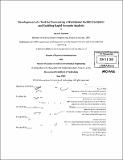| dc.contributor.advisor | David Simchi-Levi and Stephen Graves. | en_US |
| dc.contributor.author | Sutterer, Lucas B. (Lucas Benjamin) | en_US |
| dc.contributor.other | Leaders for Global Operations Program. | en_US |
| dc.date.accessioned | 2010-10-12T18:08:47Z | |
| dc.date.available | 2010-10-12T18:08:47Z | |
| dc.date.copyright | 2010 | en_US |
| dc.date.issued | 2010 | en_US |
| dc.identifier.uri | http://hdl.handle.net/1721.1/59186 | |
| dc.description | Thesis (M.B.A.)--Massachusetts Institute of Technology, Sloan School of Management; and, (S.M.)--Massachusetts Institute of Technology, Dept. of Civil and Environmental Engineering; in conjunction with the Leaders for Manufacturing Program at MIT, 2010. | en_US |
| dc.description | Cataloged from PDF version of thesis. | en_US |
| dc.description | Includes bibliographical references (p. 60). | en_US |
| dc.description.abstract | Companies in every industry, including both manufacturers and service providers, must make decisions about their operational footprint -the amount of building space required for business needs such as storing inventory and equipment and providing work areas for employees. Changes to the existing footprint often involve buying, building, expanding, leasing or selling facilities. These are long lead time decisions, making it critical to accurately forecast these needs far in advance. The problem is that many companies do not know what facility footprint requirements will be years from now. This thesis addresses the problem by investigating factors that drive space requirements and estimating trends, resulting in a five year space forecast. An approach is provided for quantifying a proactive outlook, thereby enabling more confident decisions regarding the operational footprint of the future. The thesis addresses how to adapt the forecast to create a valuable instrument that enables analysis of changing conditions and assumptions in a dynamic environment. -This provides the ability to easily and intuitively compare the outcome of multiple changes with one another. It also displays the capacity to perform analysis of complex multivariable scenarios. We explore in this thesis approaches for reducing facility size required to store inventory. These approaches include consolidation of warehouses, utilization of high bay storage and the identification and elimination of aging inventory. This research was conducted at Raytheon Company, a US-based defense contractor, with a focus on predicting warehouse space required to store inventory to support their manufacturing operations. However, these concepts apply to any situation where costly investments must be made to enable capacity to meet demand. This includes expansion or contraction of manufacturing plants, retail stores and office buildings. A proactive approach enables more insightful decisions about capital investment, construction plans and lease terms. | en_US |
| dc.description.statementofresponsibility | by Lucas B. Sutterer. | en_US |
| dc.format.extent | 62 p. | en_US |
| dc.language.iso | eng | en_US |
| dc.publisher | Massachusetts Institute of Technology | en_US |
| dc.rights | M.I.T. theses are protected by
copyright. They may be viewed from this source for any purpose, but
reproduction or distribution in any format is prohibited without written
permission. See provided URL for inquiries about permission. | en_US |
| dc.rights.uri | http://dspace.mit.edu/handle/1721.1/7582 | en_US |
| dc.subject | Sloan School of Management. | en_US |
| dc.subject | Civil and Environmental Engineering. | en_US |
| dc.subject | Leaders for Global Operations Program. | en_US |
| dc.title | Development of a tool for forecasting a warehouse facility footprint and enabling rapid scenario analysis | en_US |
| dc.type | Thesis | en_US |
| dc.description.degree | S.M. | en_US |
| dc.description.degree | M.B.A. | en_US |
| dc.contributor.department | Leaders for Global Operations Program at MIT | en_US |
| dc.contributor.department | Massachusetts Institute of Technology. Department of Civil and Environmental Engineering | |
| dc.contributor.department | Sloan School of Management | |
| dc.identifier.oclc | 659830218 | en_US |
